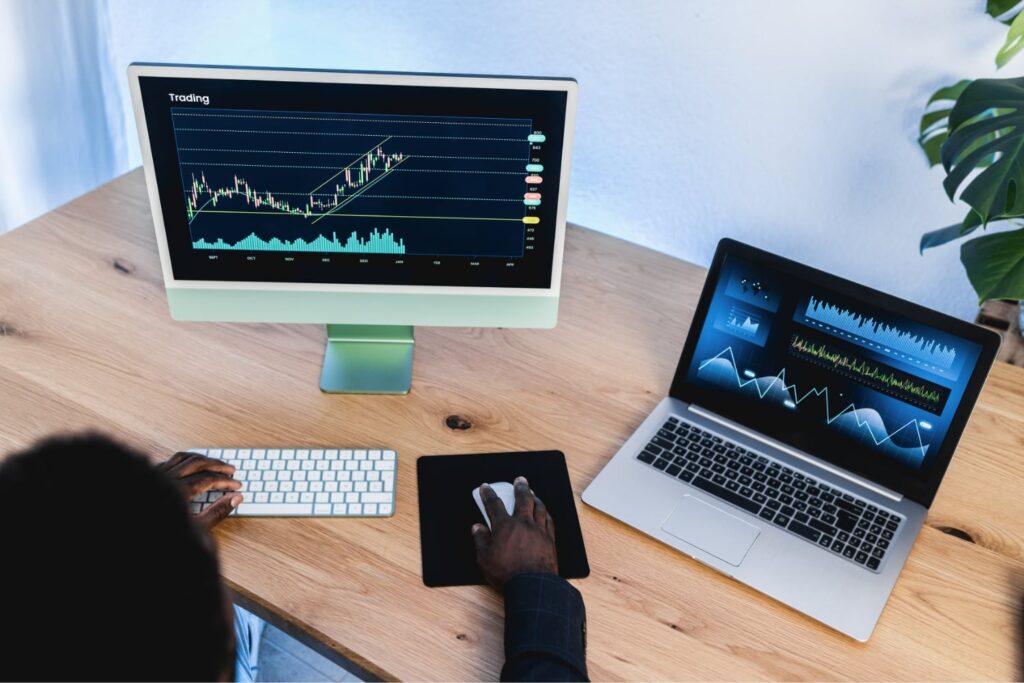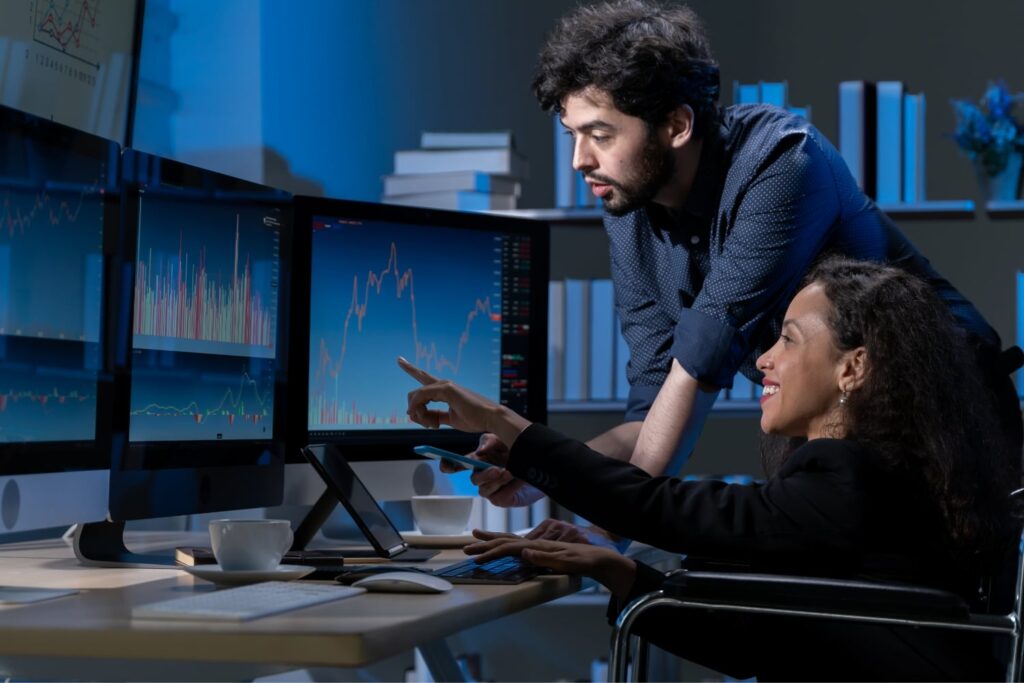Starting your forex trading journey in 2025 doesn’t have to be overwhelming. Whether you’re looking to earn extra income or build a full-time trading career, this complete guide will walk you through everything you need to know. From understanding currency pairs to making your first trade using M-Pesa, you’ll discover practical steps that work for Kenyan traders. By the end of this course, you’ll have the confidence to navigate the forex market, choose the right platforms, and start trading with a solid foundation. Let’s turn your trading dreams into reality.
What Is Forex Trading and Why Should You Care?
Forex trading involves buying and selling currencies to profit from exchange rate fluctuations. It’s the world’s largest financial market, with over $7.5 trillion traded daily. For Kenyan traders, forex offers unique advantages: you can start with as little as $10, trade 24/5, and access global markets from your smartphone. Unlike traditional investments, forex provides high liquidity and the flexibility to trade whenever international markets are open. The market operates through currency pairs like EUR/USD or GBP/JPY, where you predict whether one currency will strengthen or weaken against another. Understanding this foundation is crucial before you dive into actual trading.
Step-by-Step Guide to Starting Forex Trading in 2025
Step 1: Learn the Fundamentals
Begin by understanding key concepts like pips, lots, leverage, and margin. A pip is the smallest price movement in forex, typically 0.0001 for most pairs. Leverage allows you to control larger positions with smaller capital—for example, 1:100 leverage means $100 can control a $10,000 position. However, while leverage amplifies profits, it also magnifies losses, so use it wisely.
Step 2: Choose a Regulated Broker
Select a broker licensed by reputable authorities like CMA (Capital Markets Authority) in Kenya or international regulators like FCA or ASIC. Check out the best forex trading platforms in Kenya to compare features, spreads, and user reviews. Look for brokers offering low minimum deposits, tight spreads, and excellent customer support in your local language.
Step 3: Open a Demo Account
Before risking real money, practice with a demo account. This simulated environment lets you test strategies, understand platform navigation, and build confidence without financial risk. Spend at least 2-3 months on demo trading until you achieve consistent profitability.
Step 4: Develop Your Trading Strategy
Choose between different trading styles:
- Day Trading: Opening and closing positions within the same day
- Swing Trading: Holding positions for several days to weeks
- Scalping: Making dozens of small trades for quick profits
- Position Trading: Long-term approach holding for months
Your strategy should include entry and exit rules, risk management protocols, and criteria for selecting currency pairs.
Step 5: Fund Your Live Account
Once you’re confident, open a live account. Kenyan traders can easily deposit funds through forex trading in Kenya using M-Pesa, making the process seamless and instant. Start small—risk only what you can afford to lose while learning.
Step 6: Place Your First Trade
When placing trades, always use stop-loss orders to limit potential losses and take-profit orders to secure gains. Follow the 2% rule: never risk more than 2% of your account balance on a single trade. Monitor economic calendars for news events that might cause volatility.
Step 7: Keep Learning and Adapting
Forex trading is a continuous learning journey. Track your trades in a journal, analyze what works and what doesn’t, and refine your approach. Join trading communities, read market analysis, and stay updated on global economic developments.
Essential Forex Trading Features in 2025
FeatureDetailsMinimum Deposit$5 - $100 (broker dependent)Leverage Options1:30 to 1:500 for Kenyan tradersTrading PlatformsMetaTrader 4/5, cTrader, proprietary appsPayment MethodsM-Pesa, bank transfer, Skrill, NetellerMajor Currency PairsEUR/USD, GBP/USD, USD/JPY, AUD/USDTrading Hours24 hours (Monday-Friday)Typical Spreads0.1 - 3 pips (varies by broker)Mobile TradingAvailable on best forex trading apps in KenyaRegulatory BodiesCMA (Kenya), FCA (UK), ASIC (Australia)Risk Management ToolsStop-loss, take-profit, trailing stops
Common Mistakes to Avoid as a Beginner
Overtrading: Many beginners place too many trades, driven by emotions rather than strategy. Quality beats quantity—wait for high-probability setups.
Ignoring Risk Management: Trading without stop-losses or risking too much per trade is the fastest way to blow your account. Protect your capital first, profits second.
Chasing Losses: After a losing trade, resist the urge to immediately jump back in to “win it back.” Emotional trading leads to bigger losses.
Neglecting Education: The forex market rewards prepared traders. Don’t skip learning fundamentals before trading live money.
Following Tips Blindly: While learning from others helps, copying trades without understanding the rationale behind them prevents your growth as a trader.
Tools and Resources You Need
To succeed in forex trading, equip yourself with the right tools:
- Economic Calendar: Track major news events like interest rate decisions and employment reports
- Technical Analysis Tools: Use indicators like Moving Averages, RSI, MACD, and Fibonacci retracements
- Trading Calculator: Calculate position sizes, pip values, and risk-to-reward ratios
- Market News Sources: Follow Bloomberg, Reuters, and forex-specific news websites
- Trading Journal: Document every trade with entry/exit points, reasons, and outcomes
Mobile trading has revolutionized accessibility for Kenyan traders. You can monitor positions, analyze charts, and execute trades directly from your smartphone, making it easier to capitalize on opportunities throughout the day.
Understanding Market Analysis
Successful forex trading requires mastering two types of analysis:
Technical Analysis examines price charts, patterns, and indicators to predict future movements. Learn to identify support and resistance levels, trend lines, and chart patterns like head and shoulders or double tops.
Fundamental Analysis focuses on economic indicators, geopolitical events, and central bank policies. Interest rate changes, GDP reports, and employment data significantly impact currency values.
Combining both approaches gives you a comprehensive market view and improves your trading decisions.
Risk Management: Your Safety Net
Risk management separates profitable traders from those who lose their accounts. Never enter a trade without knowing your maximum acceptable loss. Use stop-loss orders religiously—they automatically close positions when prices move against you beyond your threshold.
The risk-reward ratio is equally important. Aim for trades where potential profit is at least twice your risk (2:1 ratio). This means you can be wrong more often than right and still be profitable overall.
Diversify your trades across different currency pairs to spread risk. If you’re trading EUR/USD, avoid simultaneously trading highly correlated pairs like EUR/GBP, as they often move together.
Psychological Aspects of Trading
Your mindset determines your success as much as your strategy. Develop discipline to follow your trading plan even when emotions tempt you otherwise. Fear and greed are every trader’s enemies—fear causes you to exit winning trades too early, while greed makes you hold losing positions too long.
Accept that losses are part of trading. Professional traders lose on 40-50% of their trades but remain profitable through superior risk management. Focus on long-term consistency rather than individual trade outcomes.
Take breaks when stressed or after significant losses. Trading while emotional leads to impulsive decisions that damage your account.
FAQ
How much money do I need to start forex trading in Kenya?
You can start forex trading with as little as $5-$10 with some brokers, though $100-$500 gives you more flexibility for proper risk management. Remember, your starting capital should be money you can afford to lose while learning.
Is forex trading legal in Kenya?
Yes, forex trading is completely legal in Kenya. However, ensure you trade with brokers regulated by the Capital Markets Authority (CMA) or other recognized international regulators to protect your funds.
Can I make a living from forex trading?
Yes, but it requires significant skill, capital, and discipline. Most successful full-time traders spent years learning and started part-time while maintaining other income sources. Focus on consistent small gains rather than get-rich-quick expectations.
How long does it take to become a profitable forex trader?
Most traders need 6-24 months of consistent practice and learning to become reliably profitable. Success depends on your dedication to education, practice time, and ability to control emotions.
What’s the best time to trade forex in Kenya?
The most active trading periods for Kenyans are during London session (11 AM – 8 PM EAT) and New York session (3 PM – 12 AM EAT) overlaps, when market volatility and liquidity are highest.
Do I need special software to trade forex?
No special software is required. Most brokers provide free trading platforms like MetaTrader 4 or 5, or proprietary platforms accessible via web browsers and mobile apps.
What’s the difference between forex and stocks?
Forex involves trading currency pairs with higher leverage, 24-hour access, and no commissions (just spreads). Stocks represent company ownership, trade during exchange hours, and typically involve lower leverage with commission fees.
How do taxes work on forex trading profits in Kenya?
Forex trading profits are subject to capital gains tax in Kenya. Consult with a tax professional to understand your obligations, as tax treatment may vary based on your trading frequency and profit levels.
Ready to take your forex education further? Check out our comprehensive guide on forex trading for beginners in Kenya for more detailed strategies and local insights. The journey to becoming a successful trader starts with that first step—take it today.



